Serving 1,234 students in grades Kindergarten-5, P.s. 321 William Penn ranks in the top 20% of all schools in New York for overall test scores (math proficiency is top 20%, and reading proficiency is top 20%).
The percentage of students achieving proficiency in math is 82% (which is higher than the New York state average of 46%). The percentage of students achieving proficiency in reading/language arts is 79% (which is higher than the New York state average of 49%).
The student:teacher ratio of 15:1 is higher than the New York state level of 11:1.
Minority enrollment is 35% of the student body (majority Hispanic and Asian), which is lower than the New York state average of 60% (majority Hispanic).
Quick Stats (2025)
- Grades: Kindergarten-5
- Enrollment: 1,234 students
- Student:Teacher Ratio: 15:1
- Minority Enrollment: 35%
- Overall Testing Rank: Top 20% in NY
- Math Proficiency: 82% (Top 20%)
- Reading Proficiency: 79% (Top 10%)
- Science Proficiency: ≥95% (Top 5%)
- Source: National Center for Education Statistics (NCES), NY Dept. of Education
Top Rankings
P.s. 321 William Penn ranks among the top 20% of public schools in New York for:
Category
Attribute
Overall Rank
Math Proficiency
Reading/Language Arts Proficiency
Science Proficiency
School Overview
P.s. 321 William Penn's student population of 1,234 students has declined by 10% over five school years.
The teacher population of 81 teachers has stayed relatively flat over five school years.
Grades Offered
Grades Kindergarten-5
(offers virtual instruction)
(offers virtual instruction)
Total Students
1,234 students
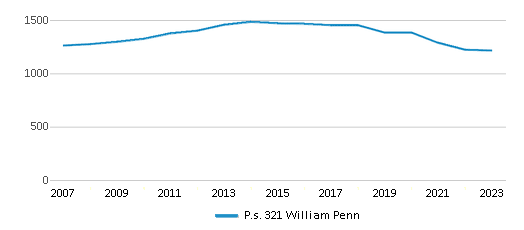
Gender %
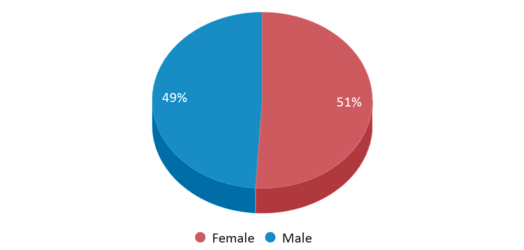
Total Classroom Teachers
81 teachers

Students by Grade
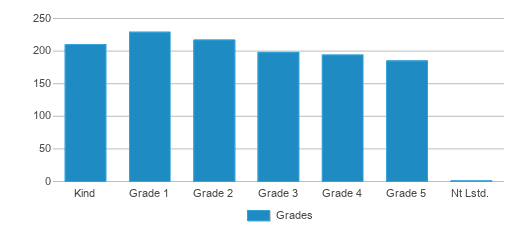
School Rankings
P.s. 321 William Penn ranks within the top 20% of all 4,377 schools in New York (based off of combined math and reading proficiency testing data).
The diversity score of P.s. 321 William Penn is 0.55, which is less than the diversity score at state average of 0.72. The school's diversity has stayed relatively flat over five school years.
Overall Testing Rank
#457 out of 4377 schools
(Top 20%)
(Top 20%)

Math Test Scores (% Proficient)
82%
46%
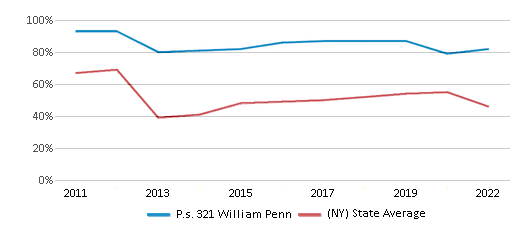
Reading/Language Arts Test Scores (% Proficient)
79%
49%
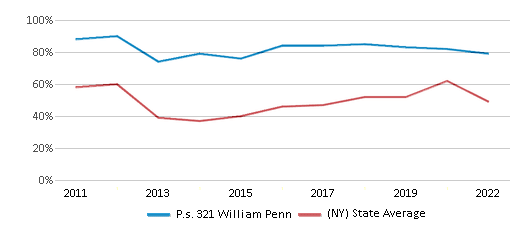
Science Test Scores (% Proficient)
≥95%
78%
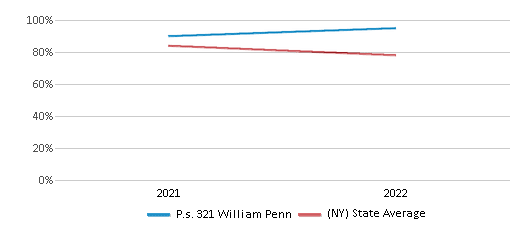
Student : Teacher Ratio
15:1
11:1
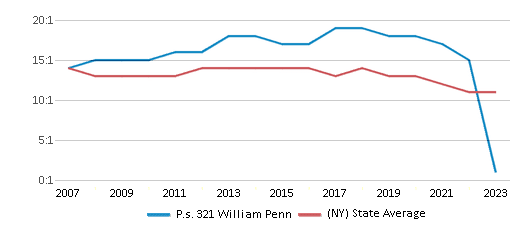
American Indian
n/a
1%

Asian
9%
10%
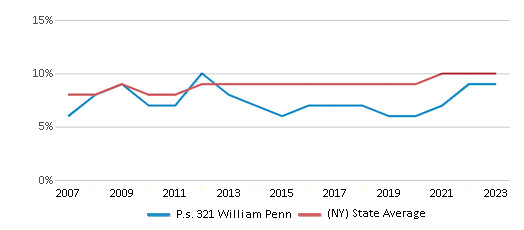
Hispanic
10%
30%
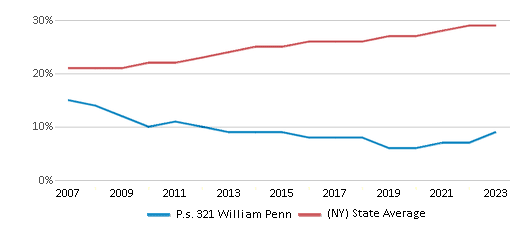
Black
3%
16%
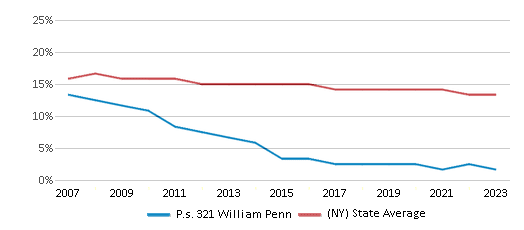
White
65%
40%
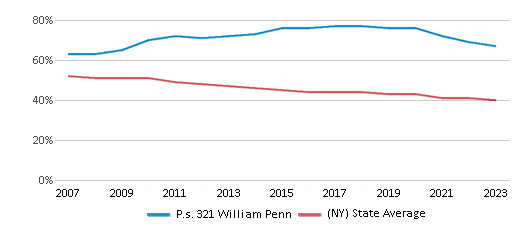
Hawaiian
n/a
n/a
Two or more races
13%
3%
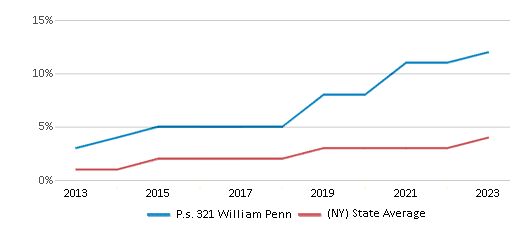
All Ethnic Groups

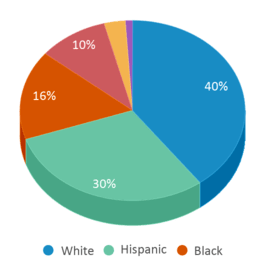
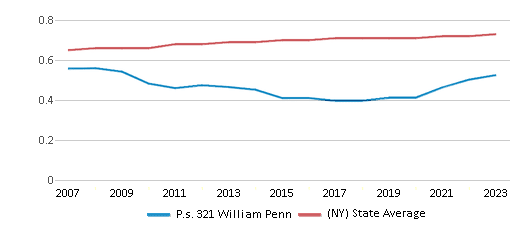
Participates in the National School Lunch Program (NSLP)
Yes
Eligible for Free Lunch
6%
54%
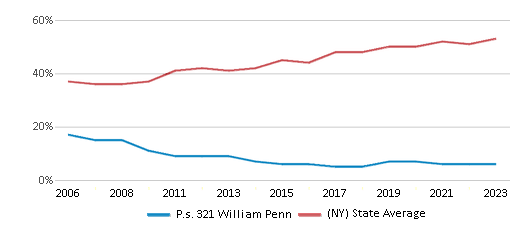
Eligible for Reduced Lunch
1%
3%
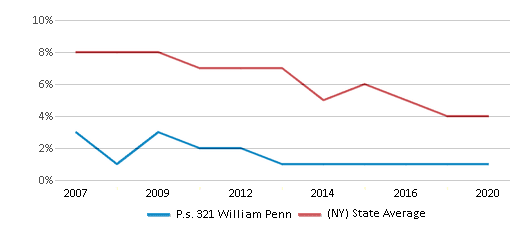
School Statewide Testing
School District Name
Source: National Center for Education Statistics (NCES), NY Dept. of Education
Profile last updated: 02/09/2025
Frequently Asked Questions
What is P.s. 321 William Penn's ranking?
P.s. 321 William Penn is ranked #457 out of 4,377 schools, which ranks it among the top 20% of public schools in New York.
What schools are P.s. 321 William Penn often compared to?
P.s. 321 William Pennis often viewed alongside schools like P.s. 39 Henry Bristow by visitors of our site.
What percent of students have achieved state testing proficiency in math and reading?
82% of students have achieved math proficiency (compared to the 46% NY state average), while 79% of students have achieved reading proficiency (compared to the 49% NY state average).
How many students attend P.s. 321 William Penn?
1,234 students attend P.s. 321 William Penn.
What is the racial composition of the student body?
65% of P.s. 321 William Penn students are White, 13% of students are Two or more races, 10% of students are Hispanic, 9% of students are Asian, and 3% of students are Black.
What is the student:teacher ratio of P.s. 321 William Penn?
P.s. 321 William Penn has a student ration of 15:1, which is higher than the New York state average of 11:1.
What grades does P.s. 321 William Penn offer ?
P.s. 321 William Penn offers enrollment in grades Kindergarten-5 (offers virtual instruction).
What school district is P.s. 321 William Penn part of?
P.s. 321 William Penn is part of New York City Geographic District #15 School District.
In what neighborhood is P.s. 321 William Penn located?
P.s. 321 William Penn is located in the Park Slope neighborhood of Brooklyn, NY. There are 13 other public schools located in Park Slope.
School Reviews
5 4/6/2019
This school was amazing for me. There was so much thought out into making the learning interactive (innumerable simulations, challenging projects, opportunities for group work). I am in high school and I still think that I got my best history education at PS 321. I also acceled at math and was got to do advanced work, which was exceptional at such a young age. This school prepared me effectively for middle school and helped me develop positive work/study habits. Thank you PS 321!!
1 9/9/2017
This school is totally overrated. The staff is rude, the needs of individual kids and families are ignored, and unless your child is perfectly self-motivated, always well-behaving, and not distracted by everything happening a very crowded classroom, he/she isn't a good fit for the school.
Review P.s. 321 William Penn. Reviews should be a few sentences in length. Please include any comments on:
- Quality of academic programs, teachers, and facilities
- Availability of music, art, sports and other extracurricular activities
Recent Articles

What Is A Charter School?
Explore the world of charter schools in this comprehensive guide. Learn about their history, how they operate, and the pros and cons of this educational innovation. Discover key facts about charter schools, including admission policies, demographics, and funding, as well as what to look for when considering a charter school for your child.

10 Reasons Why High School Sports Benefit Students
Discover the 10 compelling reasons why high school sports are beneficial for students. This comprehensive article explores how athletics enhance academic performance, foster personal growth, and develop crucial life skills. From improved fitness and time management to leadership development and community representation, learn why participating in high school sports can be a game-changer for students' overall success and well-being.

February 05, 2025
Understanding the U.S. Department of Education: Structure, Impact, and EvolutionWe explore how the Department of Education shapes American education, from its cabinet-level leadership to its impact on millions of students, written for general audiences seeking clarity on this vital institution.





